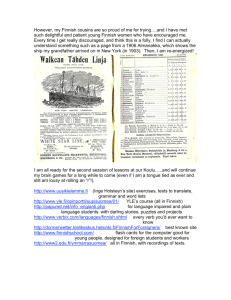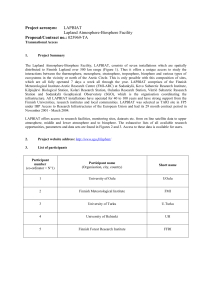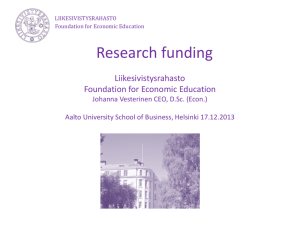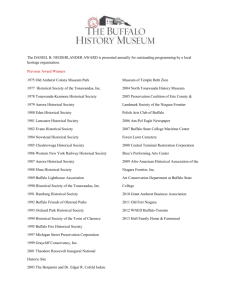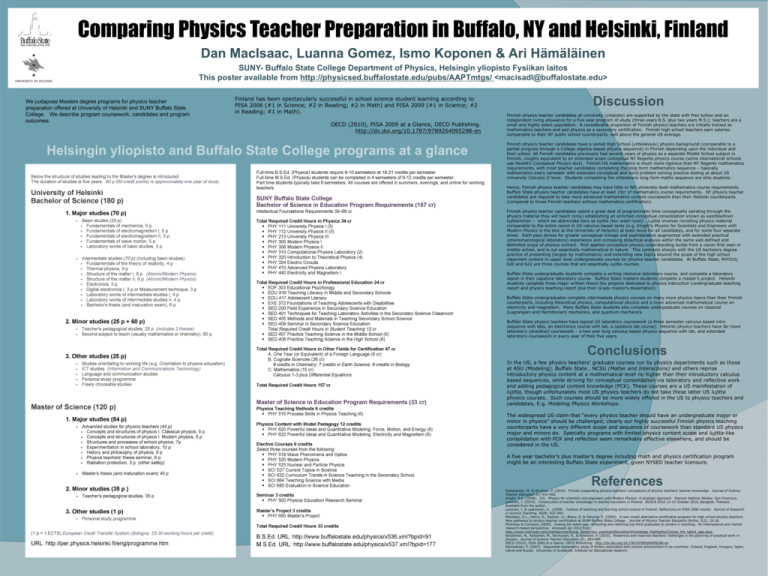
Comparing Physics Teacher Preparation in Buffalo, NY and Helsinki, Finland
Dan MacIsaac, Luanna Gomez, Ismo Koponen & Ari Hämäläinen
SUNY- Buffalo State College Department of Physics, Helsingin yliopisto Fysiikan laitos
This poster available from http://physicsed.buffalostate.edu/pubs/AAPTmtgs/ <macisadl@buffalostate.edu>
We juxtapose Masters degree programs for physics teacher
preparation offered at University of Helsinki and SUNY Buffalo State
College. We describe program coursework, candidates and program
outcomes.
Finland has been spectacularly successful in school science student learning according to
PISA 2006 (#1 in Science; #2 in Reading; #2 in Math) and PISA 2009 (#1 in Science; #2
in Reading; #1 in Math).
OECD (2010), PISA 2009 at a Glance, OECD Publishing.
http://dx.doi.org/10.1787/9789264095298-en
Helsingin yliopisto and Buffalo State College programs at a glance
Discussion
Finnish physics teacher candidates at university (yliopisto) are supported by the state with free tuition and an
independent living allowance for a five year program of study (three years B.S. plus two years M.S.); teachers are a
small and highly select population. A considerable proportion of Finnish physics teachers are initially trained as
mathematics teachers and add physics as a secondary certification. Finnish high school teachers earn salaries
comparable to their NY public school counterparts, well above the general US average.
Finnish physics teacher candidates have a varied High School (yhteiskoulu) physics background (comparable to a
partial progress through a College algebra-based physics sequence) in Finnish depending upon the individual and
their school. All Finnish candidates previously had several years of physics as a separate Middle School subject in
Finnish, roughly equivalent to an extended scope conceptual NY Regents physics course (some international schools
use Hewitt’s Conceptual Physics text). Finnish HS mathematics is much more rigorous than NY Regents mathematics
requirements, with most teacher candidates completing the long form mathematics sequence – basically
mathematics every semester with extended conceptual and word problem solving practice ending at about US
University Calculus II level. Students completing the yhteiskoulu long form maths sequence are elite students.
Hence, Finnish physics teacher candidates may have little or NO university level mathematics course requirements.
Buffalo State physics teacher candidates have at least 15cr of mathematics course requirements. NY physics teacher
candidates are required to take more advanced mathematics content coursework than their Helsinki counterparts
(compared to those Finnish teachers without mathematics certification).
Finnish physics teacher candidates spend a great deal of programmatic time conceptually spiraling through the
physics material they will teach (only) establishing an enriched conceptual consolidation known as kasitteellinen
lujittaminen – which we abbreviate here as lujitta (lou–weet–tyah). Lujitta involves revisiting physics material
comparable to the entire canon in US calculus-based texts (e.g. Knight’s Physics for Scientists and Engineers with
Modern Physics is the text at the University of Helsinki) at least twice for all candidates, and for some four separate
times. Each pass strives for greater conceptual linkage and sophistication augmented with extended practical
(phenomenological laboratory) experience and increasing didactical analysis within the same well-defined and
delimited scope of physics content. Rich applied conceptual physics understanding builds from a canon first seen in
middle school, and is not essentially mathematical in nature. This contrasts sharply with the US bachelors degree
practice of presenting (largely by mathematics) and extending new topics beyond the scope of the high school
classroom content in upper level undergraduate courses for physics teacher candidates. At Buffalo State, PHY510,
620 and 622 are three courses that are essentially lujitta courses.
Buffalo State undergraduate students complete a writing intensive laboratory course, and complete a laboratory
report in their capstone laboratory course. Buffalo State masters students complete a master’s project. Helsinki
students complete three major written thesis-like projects dedicated to physics instruction (undergraduate teaching
report and physics teaching report plus their Gradu master’s dissertation).
Buffalo State undergraduates complete intermediate physics courses on many more physics topics than their Finnish
counterparts, including theoretical physics, computational physics and a more advanced mathematical course on
electricity and magnetism. Many Buffalo State students also complete undergraduate courses on classical
(Lagrangian and Hamiltonian) mechanics, and quantum mechanics.
Buffalo State physics teachers have typical US laboratory coursework (a three semester calculus based intro
sequence with labs, an electronics course with lab, a capstone lab course). Helsinki physics teachers have far more
laboratory (practical) coursework – a two year long calculus based physics sequence with lab, and extended
laboratory coursework in every year of their five years.
Conclusions
In the US, a few physics teachers’ graduate courses run by physics departments such as those
at ASU (Modeling), Buffalo State , NCSU (Matter and Interactions) and others reprise
introductory physics content at a mathematical level no higher than their introductory calculus
based sequences, while striving for conceptual consolidation via laboratory and reflective work
and adding pedagogical content knowledge (PCK). These courses are a US manifestation of
lujitta, though unfortunately most US physics teachers do not take these latter US lujitta
physics courses. Such courses should be more widely offered in the US to physics teachers and
candidates, E.g. Modeling Physics Workshops.
The widespread US claim that “every physics teacher should have an undergraduate major or
minor in physics” should be challenged; clearly our highly successful Finnish physics teaching
counterparts have a very different scope and sequence of coursework than standard US physics
major and minors do. Specialty programs with limited physics content scope and lujitta-like
consolidation with PCK and reflection seem remarkably effective elsewhere, and should be
considered in the US.
A five year bachelor’s plus master’s degree including math and physics certification program
might be an interesting Buffalo State experiment, given NYSED teacher licensure.
References
Aiskenainen, M. & Hirvonen, P. (2010). Finnish cooperating physics teachers’ conceptions of physics teachers’ teacher knowledge. Journal of Science
Teacher Education 21; 431-450.
Knight, R.K. (2008). 2/e. Physics for scientists and engineers with Modern Physics: A strategic approach. Pearson Addison Wesley: San Francisco.
Lavonen, J. (2010). Construction of teacher knowledge in teacher education in Finland. EDUCA 2010 13-15 October 2010, Bangkok, Thailand.
Available from the author.
Lavonen, J. & Laaksonen, S. (2009). Context of teaching and learning school science in Finland: Reflections on PISA 2006 results. Journal of Research
in Science Teaching, 46(8). 922-944.
MacIsaac, D.L., Henry, D., Zawicki, J.L. Beery, D. & Falconer, K. (2004). A new model alternative certification program for high school physics teachers:
New pathways to physics teacher certification at SUNY-Buffalo State College. Journal of Physics Teacher Education Online, 2(2), 10-16.
McKinsey & Company (2009). Closing the talent gap: Attracting and retaining top-third graduates to careers in teaching. An international and market
research-based perspective. Accessed Jan 2010 from
http://www.mckinsey.com/clientservice/Social_Sector/our_practices/Education/Knowledge_Highlights/Closing_the_talent_gap.aspx.
Nivalainen, N., Asikainen, M., Sormunen, K., & Hirvonen, P. (2010). Preservice and inservice teachers’ challenges in the planning of practical work in
physics. Journal of Science Teacher Education, 21; 393-409.
OECD (2010), PISA 2009 at a Glance, OECD Publishing. http://dx.doi.org/10.1787/9789264095298-en
Reinikainen, P. (2007). Sequential explanatory study of factors associated with science achievement in six countries: Finland, England, Hungary, Japan,
Latvia and Russia. University of Jyväskylä: Institute for Educational research.


